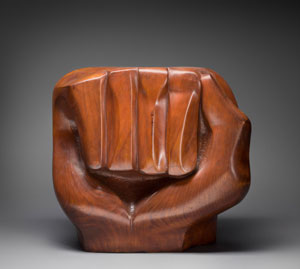1.13.25 — Never Let Her Go
Elizabeth Catlett found her subject early and never let her go. It allowed her art to span a tumultuous century and then some. It made her “A Black Revolutionary Artist and All That It Implies,” at the Brooklyn Museum through January 19. Late in a groundbreaking career, Jacob Lawrence and his Builders poured a comparable empathy and energy into the black male—and I work this together with my recent report on him as a longer review and my latest upload.
Catlett was warm in her feelings but relentless. Her work on The Negro Woman, later renamed The Black Woman, takes up the entirety of an awkward but impressive gallery. She hammers it home to her own heart in cedar and in oil, starting in 1942, before releasing it as fifteen prints the next year. Side galleries show her as a student at Howard University at just seventeen and a teacher in New Orleans, but her style and her command are in place. Portrait heads to each side range to leading figures in black history, men and women,  but they seem like an extension of the same capacious series. She lived until 2012, but one might easily think that her career lasted just five years.
but they seem like an extension of the same capacious series. She lived until 2012, but one might easily think that her career lasted just five years.
So when did she find herself? It could have been as a student, already skilled in drawing. In her training, as in her subject matter, Catlett left nothing to chance. It could have been as jobs and education took her to so much of North and South—including New York, where she exhibited in a 1943 show of “Young Negro Art” at MoMA along with Charles White, just in time for the Harlem Renaissance. It could have been in exposure to other artists as well. Barbara Hepworth and William Zorach showed her the blunt impact of sculpture as little more than a block of wood. Käthe Kollwitz, Grant Wood, and Pablo Picasso showed her painting as personal, populist, and “the primitive.”
It could have been as a child in Washington, D.C., born in Freedman’s hospital to a family that had known slavery. She observed women in all their strength, but the restrictions that they faced as well. Her 1943 series includes a sharecropper and a woman scrubbing floors, as I Have Always Worked Hard in America. Yet it also includes a woman behind a barbed-wire fence, as My Reward Has Been Bars. Mostly, though, she depicts anonymous women, facing ahead or looking upward for something more. They are portraits not of individuals, but of determination. Catlett is always accusing, but never short of hope.
Or maybe she found herself as a young woman just by looking in a mirror. She decided she had what it took, and that was that. Still, she approached her students as collaborators, hanging salon style the portraits from history. She embraced the cause of black women, but also of worker’s rights. No wonder she headed in 1946 for Mexico, where the revolution promised socialism and the Taller de Gráfica Popular (or Graphics Workshop for the People) did its best to deliver. She stayed until a comparable activism and popular spirit in the 1960s came to the United States.
At least she thought so, and her career took a new turn at last. Those first rooms surround The Dinner Party by Judy Chicago and have often hosted art by black women, including Beverly Buchanan and Lorraine O’Grady. Yet the show continues past twin doors with an artist in her fifties in support of civil rights and the Black Panthers alike. Catlett’s prints adapt easily to posters and her carvings to standing figures or a fist. She adopted linocuts long before for the jagged outlines of woodcuts and the ease of freehand drawing. As curators, Dalila Scruggs, Catherine Morris, and Mary Lee Corlett place them around a large platform for sculpture.
In truth, “all that it implies” may not be very much, but it could well be enough. The Black Woman gives the show its drive and its place in the history books. The coda loosens things up. When another sculpture, a family, floats overhead, Catlett might almost be having fun. Still, some things never change. With a self-portrait on paper in 1999, she is still facing front.
Read more, now in a feature-length article on this site.